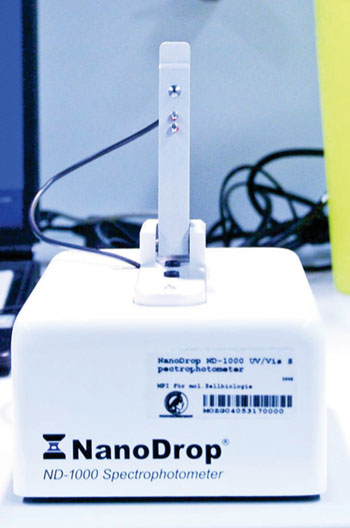Colorimetric Test Devised for Tuberculosis in Developing Areas
By LabMedica International staff writers
Posted on 28 Dec 2015
A rapid, sensitive and low-cost method has been devised for detecting tuberculosis (TB), a highly infectious disease and a major global health problem, especially in countries with developing health care systems. Posted on 28 Dec 2015
The typical way that physicians screen for TB, which is caused by the bacterium Mycobacterium tuberculosis (Mtb), is with a tuberculin skin test or an examination of a patient's sputum under a microscope. To weed out false positives, a more reliable test that involves growing Mtb cultures can be performed, but that requires weeks to complete.

Image: The ND-1000 spectrophotometer (Photo courtesy of NanoDrop).
Scientists at the Australian Institute for Bioengineering and Nanotechnology (St Lucia, QLD, Australia) and their colleagues began with a newly created nucleic acid amplification test that does not require expensive laboratory equipment to detect Mtb, but this modified test typically uses costly fluorescence technology to read the results. The team substituted the fluorescence detector with a colorimetric assay that changes to a blue hue if the infection is present, allowing health care workers to identify positive test results right away with the naked eye.
The team employed a modified Solid Phase Reversible Immobilization (SPRI) protocol) with Guanidium-HCl lysis buffer to sample for genomic DNA (gDNA) from Mtb cells. Nucleic acid amplification was performed with the TwistAmp Basic RPA Kit (TwistDx Limited; Cambridge, UK). They devised a simple colorimetric assay that utilizes the chemical oxidation of 3,3′,5,5′-tetramethylbenzidine (TMB) by isothermally functionalized DNA targets as a sensitive and specific biosensor for the detection of tuberculosis. Absorbance was determined with the ND-1000spectrophotometer (NanoDrop; Wilmington, DE, USA). Ampometry responses were measured on a workstation potentiostat (CH Instruments; Austin, TX, USA).
The team demonstrated how the modified diagnostic could be put on cheap, disposable electrochemical sensors for increased sensitivity, even in the field. Because the assay is inexpensive, quick and highly specific for the Mtb bacterium, the scientists say it could have a big impact in low-resource communities. The assays are inexpensive at USD 3.00, takes only 75 minutes, sensitive as approaching a single cell, and highly specific to M. tuberculosis. The study was published on November 30, 2015, in the journal ACS Sensors.
Related Links:
Australian Institute for Bioengineering and Nanotechnology
TwistDx Limited
NanoDrop













